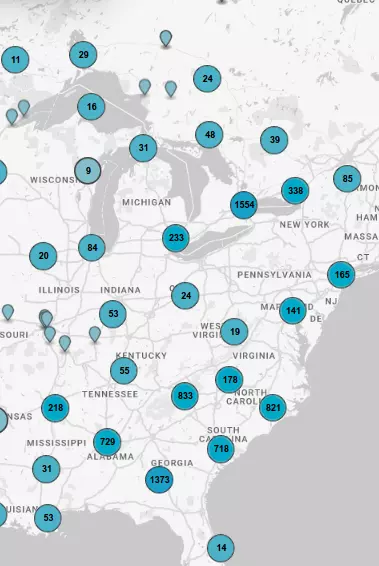Founding of Griffin
From a stump near the town spring, now covered by the embankment of the railroad, on June 8, 1840, Gen. Lewis Lawrence Griffin sold lots to the highest bidder, thus establishing the City...
- lat34
Spalding Grays
The Spalding Grays, as Co. D. 2nd Batt. Inf., was the first military unit from Spalding County to be mustered in to the Confederate Army. It was followed by 8 regular and several...
- lat34
Confederate Camp
Confederate Infantry Camp Stephens, named for Alexander H. Stephens, vice-president of Confederacy, was about ½ mile from here on McIntosh Road. Nearly all troops in the Confederate Army from...
- lat34
Confederate Camp Milner
Most Georgia troops for the Confederate Army were mobilized in Griffin. Camp Milner, the Cavalry Camp, was named for Ben Milner, prominent Spalding County man who gave financial aid in...
- lat34
Confederate Cemetery
Stonewall Cemetery is located on part of a plot given as a burial site by Gen. Lewis Lawrence Griffin when he founded Griffin in 1840. Several hundred Confederate and one Union soldier, casualties...
- lat34
Spalding County
Spalding County was created by Act of Dec. 20, 1851 from Fayette, Henry and Pike Counties. It was named for Thomas Spalding (1774-1851), native of Frederica. One of the earliest cotton and...
- lat34
Confederate Camp
Confederate Infantry Camp Stephens was named for Alexander H. Stephens, vice-president of the Confederacy. Nearly all troops in Confederacy Army from Georgia were mobilized here and at...
- lat34
Lewis Lawrence Griffin
Born in South Carolina, October 3, 1974, Lewis Lawrence Griffin moved to Georgia with his widowed mother in the early 1800´s. He fought in the Georgia Militia under General Daniel Newman...
- lat34
The City of Griffin
The first city government of Griffin, founded in 1840 by General Lewis Lawrence Griffin, was authorized in 1843 when the General Assembly of Georgia granted it a charter. The charter was accepted...
- lat34
Ringold Community
Older than Spalding County, Ringold Community grew around the two-story Ringold Masonic Lodge 90 building erected here in 1852. The lodge was established Oct. 31, 1849 at what became Walkers Mill...
- lat34
The Fannin Avengers
In 1846, when President Polk called for volunteers to fight against Mexico, a company of men organized promptly in Griffin. Calling themselves "The Fannin Avengers", they marched to Columbus where...
- lat34
The Orphan Brigade
At Bear Creek Station (Hampton), on Sept. 4, 1864, Brig. Gen. Joseph H. Lewis famous "Orphan Brigade" (2nd, 4th, 5th, 6th and 9th Kentucky Infantry) was relieved from assignment to Bates...
- lat34
Georgia Militia at Griffin
On Nov. 15, 1864. Maj. Gen. G. W. Smith, CSA, was at Lovejoy´s Station (13 miles N) with 2800 infantry of the First Division. Georgia Militia, 3 batteries, and about 250 local reserve cavalry[CSA]...
- lat34
Georgia Experiment Station
The Georgia Experiment Station, one of the first State Agricultural Experiment Stations established in the country, was located in Spalding County, Georgia in 1888. the primary objective of its...
- lat34
First Grain Elevator
The first grain elevator in Georgia was completed at Orchard Hill in 1946 by the Swint Seed and Grain Co. The original unit with a capacity of 106,000 bushels was filled with the 1946...
- lat34
First Paving
Spalding was the first County between Chicago and Miami on the old Dixie Highway with a concrete highway running from county line to county line. A demonstration strip, completed Jan. 30, 1919,...
- lat34
Site of U.S. Post Office Reynoldsville, Georgia (Side 1)
On this site was situated the Reynoldsville Post Office from April 5, 1898 to April 20, 1913. The community was named by the Post Office Department in honor of Reuben Arthur Reynolds who served...
- lat34
Sabacola El Menor (Side 1)
LOCATED IN SEMINOLE COUNTY, NEAR THE FORKS OF THE CHATTAHOOCHEE AND FLINT RIVERS, WAS A TOWN OF HITCHITI-SPEAKING LOWER CREEK INDIANS. A SPANISH MISSION, SANTA CRUZ DE SABACOLA EL MENOR,...
- lat34
Reuben Arthur Reynolds (Side 2)
This prominent agriculturist was born in Clinton, North Carolina on November 4, 1848. In 1850 he moved with his family to Decatur County, Georgia. At the age of 15 he enlisted in the...
- lat34
City of Donalsonville
According to a map `plan of Donalson` dated April 1889, the town was laid out by john earnest Donalson. On December 8, 1897, a charter, signed by Governor William Yates Atkinson, was...
- lat34
